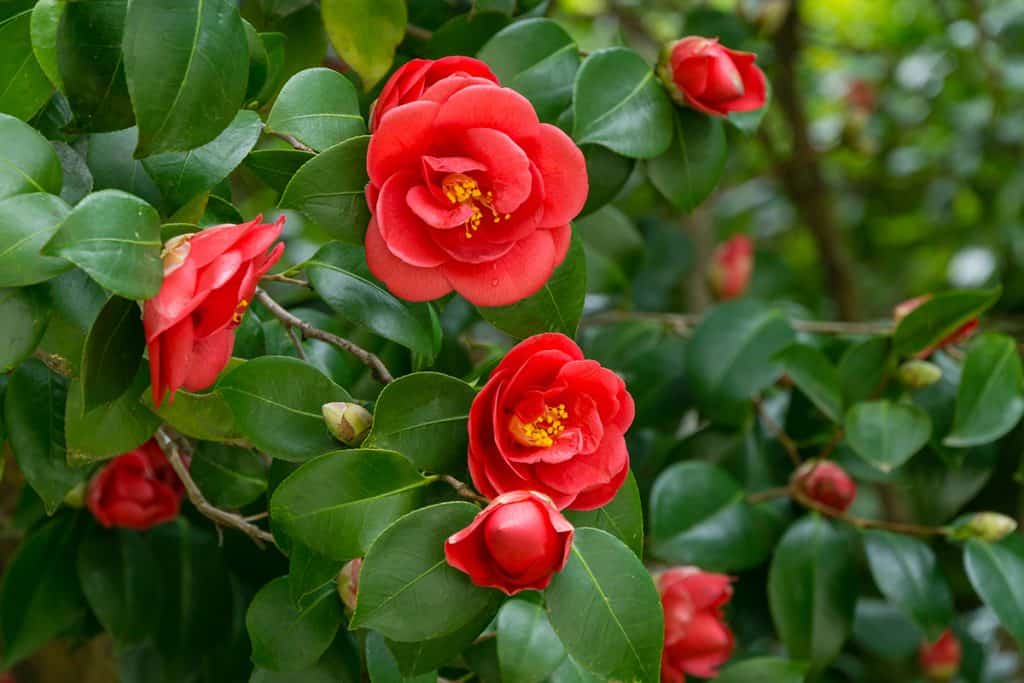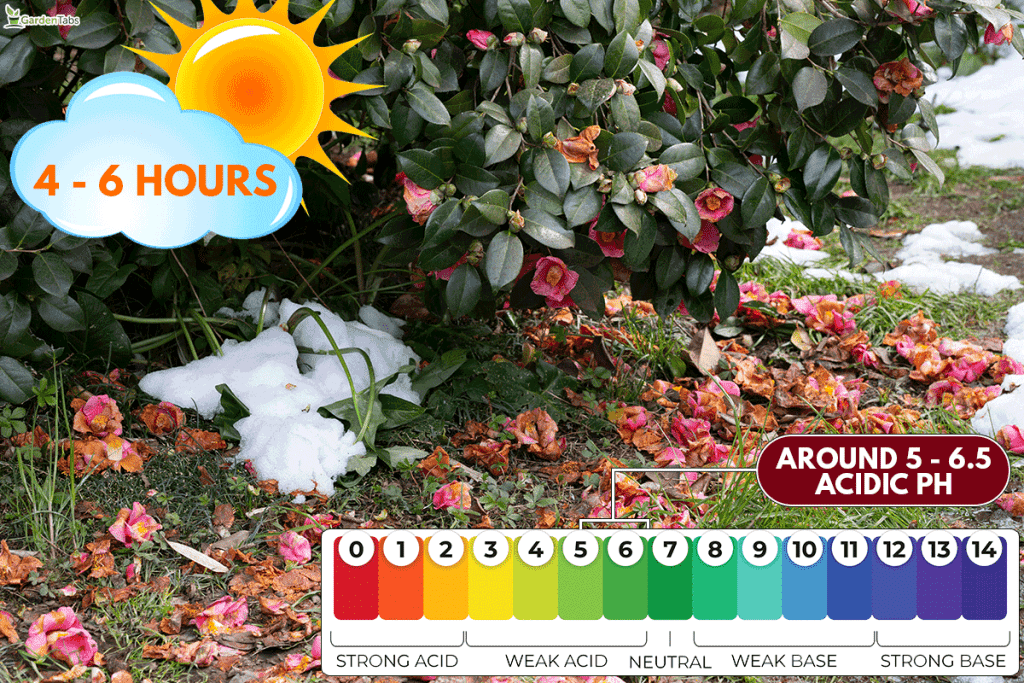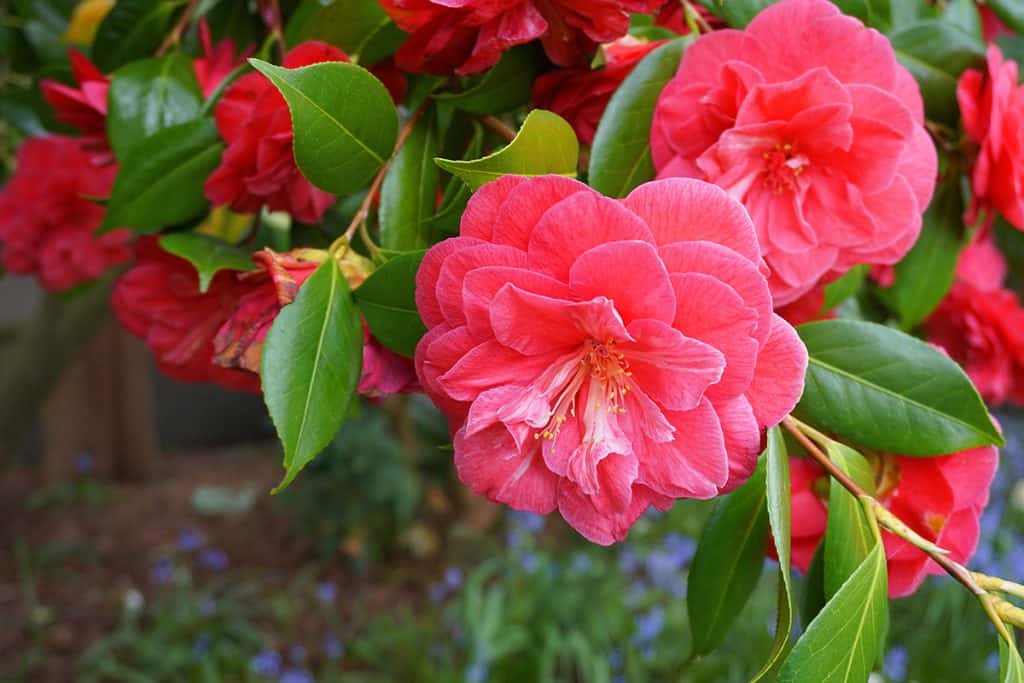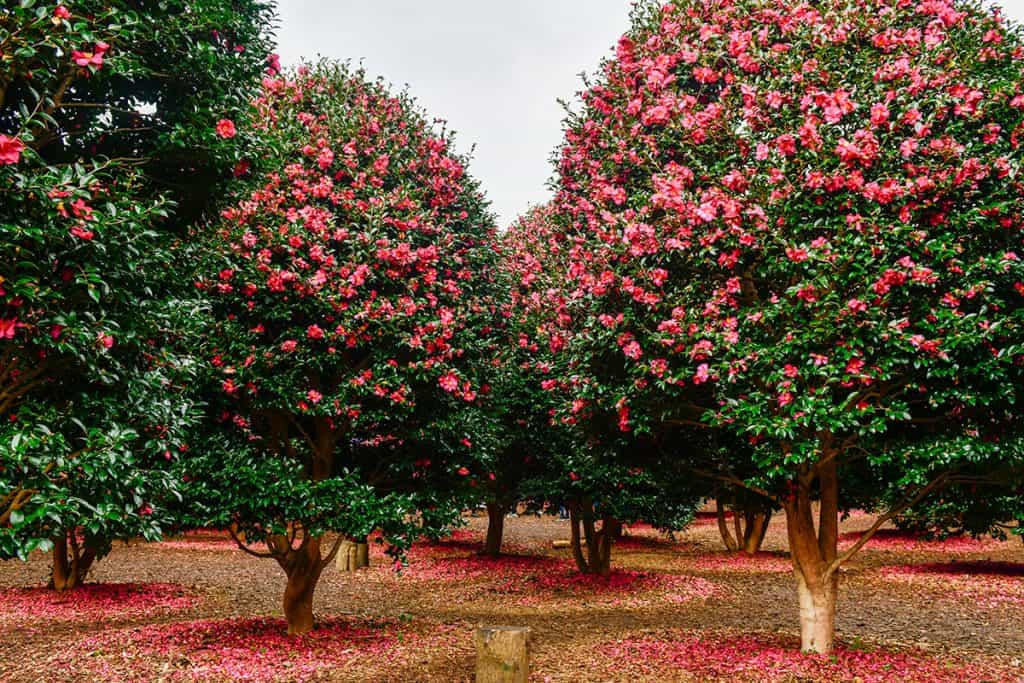Camellias are ornamental blooming shrubs that can add beauty to your garden. If you are in hotter regions, you might wonder if the plant can tolerate dry spells. We researched this topic, so keep reading to learn if camellias are drought tolerant.
The camellia is moderately drought tolerant when mature and well-rooted. The plant does not like wet, soggy soil. However, it will need more water during the summer. Also, it requires at least an inch of water per week if it is flowering.
Camellias will bloom after a drought as long as the flowering buds are intact. If the plants overdry, growth can slow down or stop altogether. When dry weather hits your area, you need to know how to take care of your camellias. Below, you can learn more about this shrub and how to care for it.
Can Camellias Survive Drought?
Yes, camellias are drought tolerant. Camellias originate from the tropics of Asia, where they can survive prolonged periods of drought.

Mature, established camellias are more drought tolerant than younger shrubs. They are the ones that need proper care during hot seasons in order to survive.
The camellia's tolerance is attributable to its tough taproot system. Varieties like sasanqua and japonica are the most drought tolerant. Other hybrid species are also resilient. The deep, mature roots help the plant endure dry weather
Camellias are popular evergreen shrubs that produce beautiful blooms. The flower is common in moderately warm US hardy zones 7-9. You will find a "Camellia Belt" from Eastern Texas to North Virginia in the US.
Camellias love full sun and moist, well-drained soil. They do not like wet, soggy soil.
Water is vital for camellias during drought. Young camellias need frequent water, while mature ones can survive five to seven days without water. You must give more attention to growing camellias so that they can establish their roots.
If camellias experience prolonged drought (lasting for months to years), they will be susceptible to pests and diseases. If you do not regularly provide water, the camellias will die.
How To Care For Camellias In A Drought
If you want your camellias to be drought tolerant, you should take the necessary actions. Read below to find out what to do before, during, and after drought to keep your camellias alive.
Before
Before the dry season, you must ensure the plant site is ready. Your camellias should grow on well-drained soil with acidic pH (around 5-6.5). It also helps to plant them on raised beds to improve drainage.

Place the camellias where they get at least four to six hours of sunlight. They will bloom well in partially shaded areas. You should protect the plants from the harsh afternoon sun. Too much sun can cause leaf burns and dropping.
Mulching around the plant will keep the soil moist and cool when the hot days come. Mulch is readily available, but it should have organic matter in it. Skipping the mulch is a risk for drought-prone camellias.
Likewise, fertilization is crucial to prepare the plant for drought. The timing and fertilizer mixture should be appropriate. Use the lowest rate of 10-10-10 fertilizer mixture.
During
During the drought, you must provide adequate water to the camellias. Give them an inch of water every 10 days to two weeks. If they are flowering, you should give them an inch of water per week.
You can give the camellias a deep water soak if you see wilting leaves or bending stems.
If you have new camellias in their first two years, check the soil moisture every three days in the dry season. Watering the plant two times every week can help. With regular watering, the growing plant can establish its roots.
You can use an automatic irrigation system, but you should time the watering for early in the morning.
Do not miss out on watering the plant during drought. Also, soak the soil thoroughly but do not let it become soggy. This can be hard work, but it will keep the camellias alive.
After
After the drought, check the camellias. Due to drought stress, you might notice drooping, scorched, or wilted leaves. Also, buds and flowers will drop if severely stressed.
The causes of drought stress include:
- Not enough irrigation
- High temperatures
- Overfertilization
When you see the signs of drought stress, water the plant immediately. Your camellias will be dry and need water to rehydrate their parts.
You should avoid pruning after the drought. Only remove the dead, diseased parts. Pruning will cause more stress to the camellias. Only prune camellias after flowering during late spring. Do not use horticultural oil sprays after the drought, as they may hinder plant growth.
Will Camellias Bloom After A Drought?
Whether or not camellias produce blooms after a drought depends on certain factors. Matured plants will still bloom if you do not prune the flowering buds right after the drought. Also, they will bloom if they are not setting the buds. If they do, the buds will fall off, and the camellias will not produce flowers.
Younger camellias may not bloom if the buds are dead or struggling to grow. The quality of the blooms may vary depending on the care you provided during the drought.
You must show extra care for the camellias that experienced drought. Keep providing water, organic fertilizer, and mulch after the drought.
Can You Revive A Dying Camellia?
Even though camellias can pull through a drought, some might be weak due to improper care and lack of preparation. The telltale signs of a dying camellia are as follows:
- Dark veins on flower petals (due to petal blight)
- Discoloration of leaves
- Browning, drooping, and sudden wilting of leaves
- Mottling or yellowing of the leaves (caused by the camellia yellow mottle leaf virus)
- Stunted growth
- Surfacing of the roots
If your camellias are dying, there is still a way to help them. You can revive them by following these tips:
- Cut the dead branches of the trunk. Remove any dry, brittle, faded leaves.
- If simple pruning does not improve the plant's condition, cut back the shrub to 1/3 of its current size. Repeat cutting back each year for three years.
- Continue providing adequate water, sun exposure, mulch, and fertilizer to the camellias.
Cutting back camellias can help regenerate branches. Your camellias can become bushy and lively again. It may take time, but do not lose hope.
Should You Transplant Camellias After A Drought?

You should not transplant camellias immediately after a drought. Doing so will add more stress to the plants. The roots are vulnerable to damage. If severed, you might compromise the camellias' growth.
The best time to transplant camellias is during winter when they are dormant. You can transfer the plants to a shaded area to protect them from the harsh sun.
If you want to easily transfer the plants when the drought comes, you can grow camellias in pots. When the drought arrives, you won't have to worry about the camellias drying out.
How To Care For Camellias

You can keep camellias resilient during drought or other seasonal changes if you provide them with what they need.
Here are general care tips for camellias:
- Mulch and fertilize the plant site.
- Give the plant adequate sunlight.
- Protect the plant from strong winds and cold.
- Check for infestations.
- Prune camellias at the right time.
- Allow the plants to grow to their natural size.
Keep an eye on your camellia plants regardless of the environmental conditions. If you want more guidance, you can ask for advice from camellia specialists.
In Summary

Camellias are drought tolerant. With their tough, well-established roots, they can survive for days without water. You must prepare the plants before dry weather arrives. Under the right conditions, camellias can survive drought.
If you want to keep them healthy, you need to provide water regularly. Water is vital for keeping the plants nourished. After the drought, you must be careful not to put additional stress on your camellias.
To learn more, check out some of our other posts
